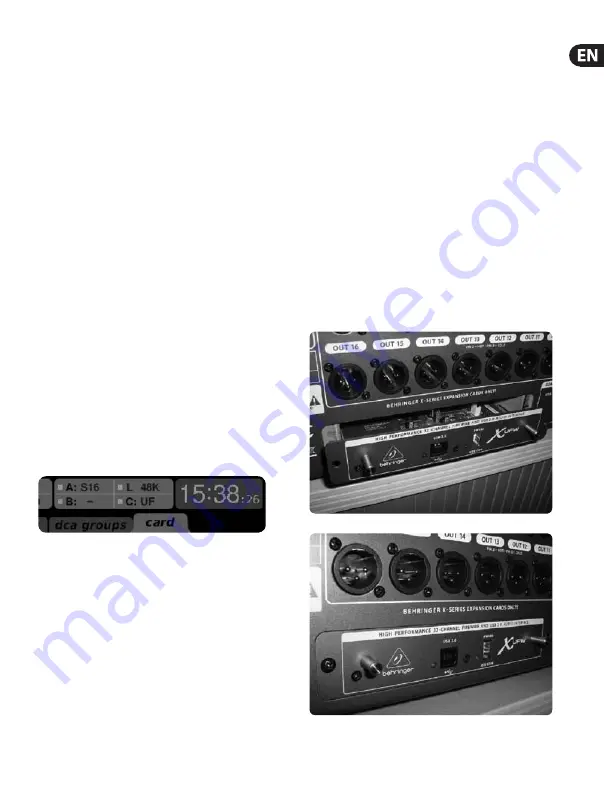
1. X-UF Interface Operation Guide
1.1 Host system requirements for X-UF
FireWire/USB interface expansion card
Check the BEHRINGER website at behringer.com for updates
of X-UF firmware or system requirements. Please find the
recommended hardware/software minimum configurations in the
specifications section.
1.2 The BEHRINGER X-UF High-
Performance 32-Channel 24-Bit FireWire/
USB Audio Interface
The X-UF option card gives 32 channel, bi-directional audio I/O via
USB 2.0 and FireWire 400 serial bus for Mac computers or Windows-
based applications. The simultaneous 32-in, 32-out audio channels
enable for extremely powerful studio and live applications. You can
run virtual live sound checks or 32-track high-quality studio
recordings, while at the same time remote operating your DAW
via HUI/MackieControl emulation. The high speed 24-bit signal
transmission and ultra-low latency ASIO drivers and CoreAudio
compatibility even allow inserting audio plugins on your PC to
perform advanced outboard processing.
1.3 Configuring the X-UF option card for
use in the console
The console will automatically detect the X-UF option card during
the regular boot cycle, and it will display the card’s presence in
several instances.
The green square in front of “C: UF” indicates that the card is
installed and working properly.
2. Installing a BEHRINGER
Interface Card
Before you install an I/O card to the expansion slot of the console,
you must check the BEHRINGER website to verify whether the
console supports that card. behringer.com
CAUTION
: Before installing optional I/O cards into the console,
you must make sure that the console’s power switch is turned off.
Malfunctions or electrical shock may occur otherwise.
To install an interface I/O card:
1. Make sure that the mixer’s power is turned off.
2. Loosen the screws that fasten the slot, then remove the slot
cover and keep it in a safe place.
3. Before removing the X-UF card from its protective bag, it is
recommended to touch the grounded metal chassis of the
console to prevent electrostatic discharges affecting the
sensitive electronic components. It is generally a good idea
to hold the card either by the face plate or by the two small
handles, but never touching the components on the circuit
board directly.
4. Align both edges of the card with the guide rails inside the
slot and carefully insert the card into the slot. Push the card
all the way into the slot to ensure that the contacts of the card
are correctly inserted into the connector inside.
5. Fasten the card using the included screws. Be aware that
damage or malfunctions may occur if the card is not fastened.
11
Quick Start Guide
Summary of Contents for X-UF
Page 26: ...We Hear You ...












































